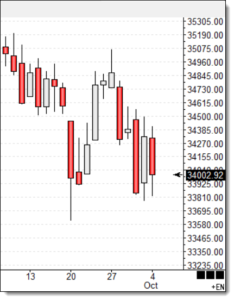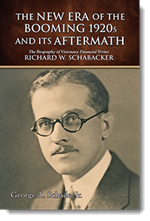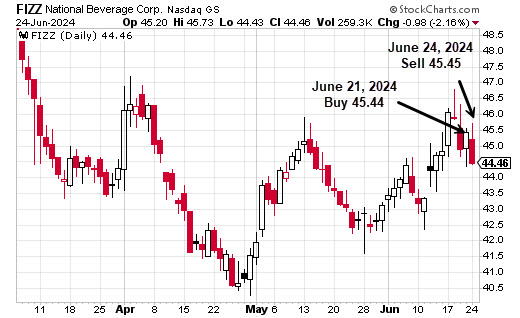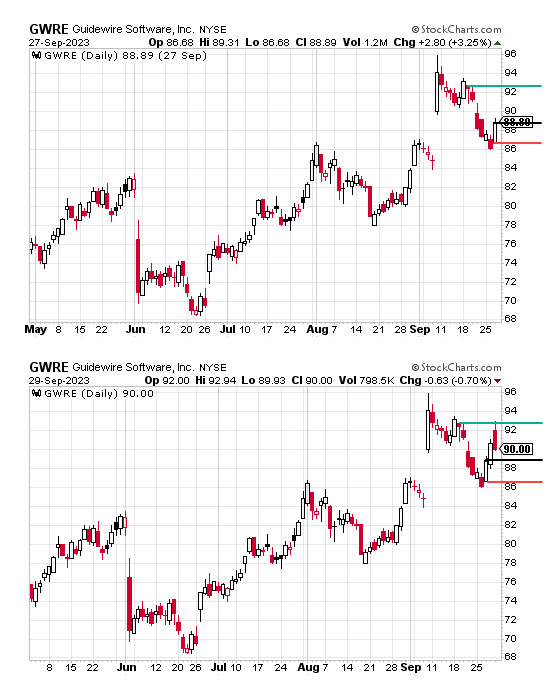Brightstar Blog
Welcome to Brightstar Blog! Here, you can receive exclusive access to informative articles, media presentations, and other forms of educational help for traders. An opportunity to log in or register will be presented when you click on a More with Free Membership link below. Other links provide access to content for non-registered users.
General Interest
Identifying the Big Turn
October can bring some of the most powerful market declines of the year. November introduces the “best six months” of a new annual cycle. Based upon market data that extends back to 1950, the Dow Jones Industrial Average (INDU) tends to display its greatest average rise during the November–April period. The S&P 500 Index (SPX) follows with equally impressive results. (For specific numbers, see Stock Trader’s Almanac 2023, pp. 52, 54, 102).
Professional market participants are fully aware of this annual cyclicality and attempt to play it as best they can. The tricky part is determining when the major indices have concluded their October drop—which can occur as various times during the month—and when prices will begin to rise on a sustained basis. Despite current inflation levels and elevated interest rates (negatives for stocks), INDU and SPX made their big turn on October 31. At the time, circumstances may have looked a bit uncertain. But why were market professionals more confident in the turn?
Straight Talk about the Role of Money
In daily life, money is something that we earn, save, and spend. No surprise there. Did you know, however, that the flow of money through the economy significantly impacts the cost of goods and services, interest rates, and market performance? Before your eyes glaze over with the thought that this stuff is for economists only, I invite you to take a few moments and read on. Here, I offer a very simple explanation of how money works, how it impacts us where we live, and how to limit losses in a market downtrend.
Attitudes that Sabotage Market Success
During the early part of my adult life, I counseled individuals and married couples. I saw people with various problems and tried to help them embrace a more healthy and productive existence. In the process, however, I also noted that some people seemed forever stuck in the mud. Their inability to move forward in life was rooted in three particular attitudes—the same ones that keep traders from achieving long-term success.
In Street Name
When stock initially became available to the public, it appeared in paper form. Known as a stock certificate, this piece of paper represented partial ownership in a company.[1] It often contained relevant details such as the name of the shareholder, a transaction date, number of shares, identification number, names of executives, and a unique graphical design that identified the company. If you were a shareholder, presentation of a stock certificate was the only way to prove that shares were held “in your name.”
Stock Splits
When a company wants to manage the price of its stock in a direct manner, it often seeks to split the stock. A split focuses on the inverse relationship between stock price and the number of shares outstanding (shares held by all shareholders). Two general types of splits are possible. One split tends to reflect a positive outlook on the company. The other is an indication of looming disaster. If an announcement is made about an upcoming split, the nature of the split can help you make a decision about what to do—whether to purchase shares or divest yourself of them.
Why the Yield Curve Matters
Many people view interest rates as avenues for making or losing money. They think of the amount of money that they will receive from a financial institution for sitting on their cash. Or, they ponder the amount that they will pay to a lender for securing a loan. Seldom do they realize that these same rates are a powerful indicator of future economic conditions that will impact their lives in a much larger way.
Benefits of Volatility
Market commentators often convey the message that volatility is a bad thing. At best, it is portrayed as a condition that resembles a common cold—something that is quite annoying, but temporary in duration. At worst, it is a type of flu that can have disastrous consequences if it persists over long periods of time. But are these characterizations really true? How can traders benefit from volatility even when others claim that it is undesirable?
E-Mini Dow Day Trading
Why I Day Trade the E-mini Dow
Among those who day trade stock index futures, the E-mini Dow futures market is one of the best kept secrets on Wall Street. Many E-mini participants trade the S&P 500 (ES), Nasdaq-100 (NQ) or Russell 2000 (RTY). For various reasons, these markets are not as easy to trade. ES is mostly controlled by institutions which gives it a jerky institutional flavor in moving from one price level to another. Continued…
How Long Does it Take to Learn?
Traders may be classified as professionals or nonprofessionals. The first group is largely comprised of individuals who trade for financial firms, manage other people’s portfolios, and otherwise make their living from trading. Employers often train their own people and impose their own rules on performance. For these reasons and others, I usually prefer to work with nonprofessionals. Continued…
Making Sense of Net Change in Day Trading
Data providers routinely include “net change” among their price quotations. Net change is based upon the difference between a closing price from the previous day and the current market price. In futures trading, the closing price is not as obvious as one might expect because it can appear in two forms: last price or settlement price.
The last price is the price at which the market traded when it closed on the previous day. It is a straightforward quote and appears on intraday charts. The settlement price is more complicated. This price is the fair market value of the contract traded as determined by a number of factors selected by the exchange. It is displayed as the official price for the end of the day and appears on daily and higher time-frame charts, but not intraday charts.
Because the last price and settlement price are often different from one another, the net change values based upon these prices are also different. As a day trader of E-mini Dow futures, you may notice a difference between the net change provided as a quote and the distance between yesterday’s closing price and the current market price on your intraday charts. When that happens, your data provider is likely using the settlement price in calculating net change rather than the last price.
Swing Trading
Trading for Dividends eLearning Course
Begins September 9
Dividend capture is a short-term trading strategy that enables you to obtain the dividends (free money) that companies offer shareholders without a long-term stock investment or large account balance. Our 8-week eLearning course will help you understand the dividend-payment process, select dividend trades efficiently, make timely stock purchases, manage market positions in a risk-averse manner, and plan trades throughout the year.
Little technical analysis is needed to trade. Profits are obtained mostly by understanding the dividend delivery process and executing trades that are consistent with it.
One way to execute a dividend capture trade is to buy stock before the ex-dividend date and sell it on the ex-dividend date. The trade example below illustrates how a large profit can be obtained in a short period of time with very little capital. Further instruction is provided in the fall edition of our Trading for Dividends eLearning course.
Company: National Beverage Corp. (FIZZ)
Special Dividend: $3.25 per share
Stock Price at Close on June 21, 2024: $45.44
Shares Purchased: $10,000 / $45.44 = 220 (rounded down)
Stock Sold on June 24, 2024: $45.45
Expected Dividend Payment: 220 x $3.25 = $715.00
Chart courtesy of StockCharts.com
A Gem of a Pattern
Above the Stomach (ATS) is a powerful candlestick pattern that forecasts upward price movement and offers a wonderful opportunity to make money in 1-3 days.
Below, we provide two examples of recent ATS trade opportunities that were profitable based upon instruction in our eLearning course, Above the Stomach Candlestick Trading.
Each upper chart shows the parameters of a trade when a position is established. Each lower chart displays the progress of the trade until its conclusion.
EXAMPLE #1
Guidewire Software, Inc. (GWRE)
TRADE PARAMETERS
Position Size: 100 shares
Entry: 88.89 (black line) | September 28, 2023
Initial Stop: 86.68 (red line)
Target: 92.82 (green line) | September 29, 2023
RESULTS
With a 100-share position, gross profit was $393.00 (92.82–88.89 x 100). In 2 days of trading, the return on investment (ROI) was 4.42% with an annualized ROI of 530%.
Charts courtesy of StockCharts.com
EXAMPLE #2
Burlington Stores, Inc. (BURL)
TRADE PARAMETERS
Position Size: 100 shares
Entry: 186.64 (black line) | December 19, 2023
Initial Stop: 183.41 (red line)
Target: 192.92 (green line) | December 20, 2023
RESULTS
With a 100-share position, gross profit was $628.00 (192.92-186.64 x 100). In 1 day of trading, the return on investment (ROI) was 3.36% with an annualized ROI of 806.40%.
Charts courtesy of StockCharts.com
Position Trading
S&P 500 Index
The S&P 500 Index ($SPX) contains 500 of the most prominent publicly-traded companies in the United States. It was formed on March 4, 1957. The original name was S&P 500 Stock Composite Index.
Professional traders and portfolio managers view the index as the most important general measure of stock performance. It also best represents the economic direction of the country. For many investors, some portion of their retirement money follows the $SPX.
Determining Market Breadth with the New High-New Low Index
A physician may check blood pressure, pulse, respiration rate, and body temperature to assess the general health of a patient. In the same way, traders can examine internal aspects of the stock markets to determine whether long-term market direction is strong and healthy.
Market internals tell us whether the average stock is performing the same way as a major market index. They also tell us if index direction is simply the result of large moves made by a handful of stocks. Several measures of internal market strength (breadth) are available to traders. On the daily chart that follows, we look at a popular measure known as the New High-New Low Index ($USHL) and apply it to activity in the S&P 500 Index ($SPX).
Recommended Resources
Computer Equipment for Traders
In the world of trading, reliable computer equipment is critical for success. Ever-changing market conditions and rapid price movement require traders to have powerful systems that keep up with the demands of real-time data analysis and provide a competitive edge in the markets.
At Brightstar Training, LLC, we are sometimes asked for recommendations related to computers, accessories, and peripherals. As a result, I have written a special article for traders who want to move beyond outdated technology, dive into details, and stay ahead of the game. Continued…
Ensign Charting Software
 Since 1981, company founder Howard Arrington and his team have sought to create versatile products through unusual responsiveness to customer input. As a result, Ensign charting software is updated with great frequency (several times each month) and contains a large number of useful features that are difficult to find elsewhere. The price for leasing the software is attractive. Rather than increasing prices every year, Ensign maintains a reasonable and stable price structure while offering a high-quality product.
Since 1981, company founder Howard Arrington and his team have sought to create versatile products through unusual responsiveness to customer input. As a result, Ensign charting software is updated with great frequency (several times each month) and contains a large number of useful features that are difficult to find elsewhere. The price for leasing the software is attractive. Rather than increasing prices every year, Ensign maintains a reasonable and stable price structure while offering a high-quality product.
Stock Trader’s Almanac 2024
 For many years, Stock Trader’s Almanac (STA) has endeavored to provide “the necessary tools and data to invest and trade successfully (Hirsch & Mistal, 2024, p. 7).” It was originally created by Yale Hirsch (1923-1921) and reflects his lifelong interest in market history, cycles, and price patterns. His son, Jeffrey, joined Hirsch Holdings, Inc. in 1990 and eventually became editor-in-chief with a desire to improve the content and application of the almanac. Continued…
For many years, Stock Trader’s Almanac (STA) has endeavored to provide “the necessary tools and data to invest and trade successfully (Hirsch & Mistal, 2024, p. 7).” It was originally created by Yale Hirsch (1923-1921) and reflects his lifelong interest in market history, cycles, and price patterns. His son, Jeffrey, joined Hirsch Holdings, Inc. in 1990 and eventually became editor-in-chief with a desire to improve the content and application of the almanac. Continued…
Reminiscences of a Stock Operator
by Edwin Lefèvre (annotations by Jon D. Markman)
 This book is a favorite among traders. It recounts the life and times of renowned speculator Jesse Livermore (1877-1940). Told in the first person by a fictional character named Larry Livingston (Livermore), the story describes one trader’s rise from amateur to professional. Though written as a historical novel, the vast majority of people and events in the book are real. Here, annotator Jon D. Markman enlightens us with photos, information, and commentary that provide a meaningful context for understanding Livermore’s journey.
This book is a favorite among traders. It recounts the life and times of renowned speculator Jesse Livermore (1877-1940). Told in the first person by a fictional character named Larry Livingston (Livermore), the story describes one trader’s rise from amateur to professional. Though written as a historical novel, the vast majority of people and events in the book are real. Here, annotator Jon D. Markman enlightens us with photos, information, and commentary that provide a meaningful context for understanding Livermore’s journey.
Perhaps the most interesting aspect of the book is that it shows how Livermore evolved as a trader through careful observation of markets and detailed evaluation of his trading behavior. While participating in both stock and commodity markets, he developed a stable set of trading procedures that shaped his career and may be employed in modern markets. Continued…
StockCharts.com
![]() StockCharts.com offers numerous features designed to assist market participants with making sound decisions. It combines technical tools and educational information in a massive website. Charts and stock scanners are particularly useful for active traders. They enable easy identification and analysis of trades. The user may develop code for scans and use it to locate trades based upon personal preference. Several free features are available. Many more desirable features are provided for a modest fee.
StockCharts.com offers numerous features designed to assist market participants with making sound decisions. It combines technical tools and educational information in a massive website. Charts and stock scanners are particularly useful for active traders. They enable easy identification and analysis of trades. The user may develop code for scans and use it to locate trades based upon personal preference. Several free features are available. Many more desirable features are provided for a modest fee.
Biography
The New Era of the Booming 1920s and Its Aftermath
The Biography of Visionary Financial Writer Richard W. Schabacker
by George A. Schade, Jr.
 In this day and age, history is often viewed as a collection of facts and figures rather than what it really is — a rearview look at real people who struggled to make sense of their times and offer contributions to the world.
In this day and age, history is often viewed as a collection of facts and figures rather than what it really is — a rearview look at real people who struggled to make sense of their times and offer contributions to the world.
George Schade’s journey through the brief but meaningful life of Richard W. Schabacker (1899-1935) offers readers a rare look at the evolution of financial markets in the early part of the twentieth century. During his employment at Forbes magazine (1925-1935), Schabacker became financial editor and wrote numerous articles that educated subscribers. As Schade points out, Schabacker’s keen insights and obvious writing ability enabled him to spread the word about the importance of technical trading.
A lesser-known fact about Schabacker is that he published a correspondence course in 1932 that covered chart formations and trading tactics. After his death, brother-in-law Robert Edwards collaborated with Albert Kimball to present much of the course in book form. This 1937 text later served as the basis for Part I of Technical Analysis of Stock Trends published by Edwards and McGee in 1948. Today, Edwards and McGee is widely regarded as the early Bible of technical analysis. Historically, though, it is clear that a substantial portion of this Bible came from Schabacker.
Schade’s book is detailed and well-researched. It is a must read for market participants who desire to trace the roots of technical analysis and trading.



